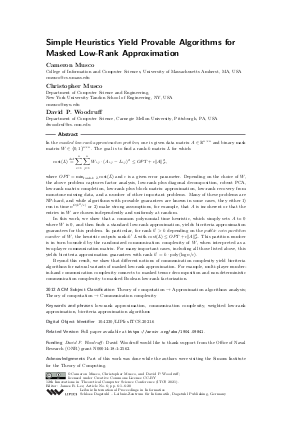@InProceedings{musco_et_al:LIPIcs.ITCS.2021.6,
author = {Musco, Cameron and Musco, Christopher and Woodruff, David P.},
title = {{Simple Heuristics Yield Provable Algorithms for Masked Low-Rank Approximation}},
booktitle = {12th Innovations in Theoretical Computer Science Conference (ITCS 2021)},
pages = {6:1--6:20},
series = {Leibniz International Proceedings in Informatics (LIPIcs)},
ISBN = {978-3-95977-177-1},
ISSN = {1868-8969},
year = {2021},
volume = {185},
editor = {Lee, James R.},
publisher = {Schloss Dagstuhl -- Leibniz-Zentrum f{\"u}r Informatik},
address = {Dagstuhl, Germany},
URL = {https://drops.dagstuhl.de/entities/document/10.4230/LIPIcs.ITCS.2021.6},
URN = {urn:nbn:de:0030-drops-135452},
doi = {10.4230/LIPIcs.ITCS.2021.6},
annote = {Keywords: low-rank approximation, communication complexity, weighted low-rank approximation, bicriteria approximation algorithms}
}

 Creative Commons Attribution 3.0 Unported license
Creative Commons Attribution 3.0 Unported license




































































